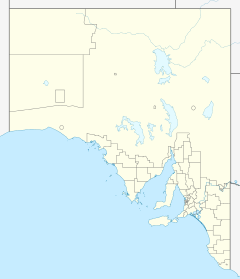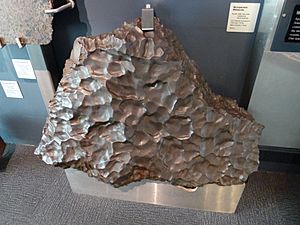Murnpeowie facts for kids
Murnpeowie, also known as Murnpeowie Station, is a very large piece of land in the outback of South Australia. It is a 'pastoral lease,' which means people rent the land from the government to raise animals.
This land used to be a 'sheep station,' where many sheep were raised for their wool. Now, it is a 'cattle station,' raising cattle instead. The government officially named this area "Murnpeowie" on April 26, 2013.
Murnpeowie is about 96 kilometres (60 miles) east of Marree. It is also about 102 kilometres (63 miles) northeast of Lyndhurst. The land here has flat, stony areas called 'gibber plains.' These plains are good for growing special grasses like Mitchell grass and saltbush.
The name "Murnpeowie" comes from the Aboriginal language. It means place of the bronzewing pigeon.
History of Murnpeowie Station
In 1857, a man named John Baker started renting land in this area. He added more land throughout the 1860s. His land was next to areas rented by Thomas Elder.
When John Baker passed away in 1872, Thomas Elder bought all of Baker's land. He combined it with his own to create one huge property. This property was about 4,000 square miles (10,000 square kilometres) in size. It was named Blanchewater Horse Station. At that time, it could hold about 20,000 horses.
The main house, called the homestead, was built in the 1880s. The 'woolshed,' where sheep were shorn for their wool, was built in 1890. Both buildings were made with strong stone walls and had round iron roofs.
By 1894, Murnpeowie Station was very busy. Workers were shearing 106,000 sheep. This produced 2,400 large bundles of wool, called bales. In 1909, even more sheep were shorn, with a total of 120,000.
The old buildings of the Blanchewater Homestead are very important. They are listed on the South Australian Heritage Register. This means they are protected because of their history.
The Murnpeowie Meteorite
In 1910, some workers on the station found a very unusual rock. It weighed about 2,520 pounds (1,143 kilograms). At first, they thought it was just a big rock. But when they hit it with a hammer, it made a strange, bell-like sound.
They sent a small piece of the rock to the School of Mines for testing. It turned out to be a meteorite, a rock from outer space! The meteorite was then given to a museum.
Changes Over Time
In 1920, the station was home to 90,000 sheep. By 1924, the property was still about 4,000 square miles (10,000 square kilometres). It had about 70,000 sheep living there. By 1935, the station was a bit smaller, about 3,500 square miles (9,100 square kilometres), and had 60,000 sheep.
In 1952, the area faced tough times. There was a long period without rain, called a drought. Then, huge dust storms swept across the land.
In 1998, David and Nell Brook bought Murnpeowie Station. They decided to raise Poll-Hereford cattle instead of sheep. Their family also owns other large stations, like Adria Downs and Cordillo Downs. All their land is 'certified organic,' which means they raise their animals using natural methods. Together, their properties cover a huge area of 30,000 square kilometres (11,583 square miles).




